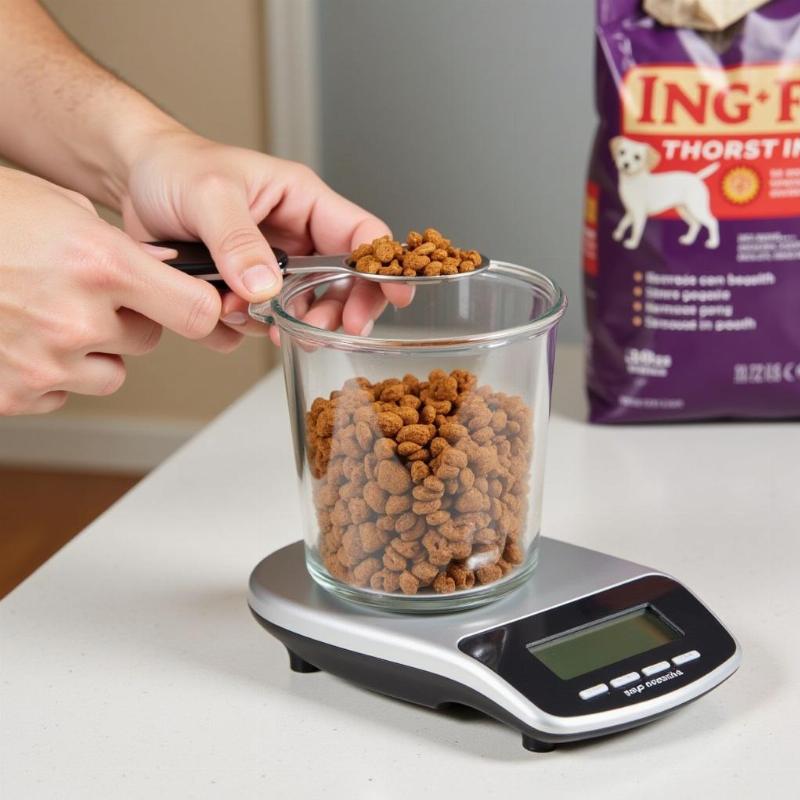Understanding how much food your dog needs is crucial for their health and well-being. While bag sizes are typically listed in pounds (lbs), many dog owners measure their dog’s food in cups. So, if you’ve just bought a 22 lb bag of dog food, you’re probably wondering how many cups that translates to. The answer, unfortunately, isn’t a simple one-size-fits-all. It depends on the type of kibble and its density.
Kibble size and density vary considerably between brands and even formulas within the same brand. A large, airy kibble will occupy more space per cup compared to a small, dense kibble. This means a cup of large kibble will weigh less than a cup of small, dense kibble. Therefore, a 22 lb bag of large kibble will contain more cups than a 22 lb bag of small, dense kibble.
Calculating Cups in Your 22 lb Bag of Dog Food
While there’s no magic number, a general guideline is that a pound of dry dog food is approximately 3 to 4 cups. Using this average, a 22 lb bag of dog food would contain roughly 66 to 88 cups. However, this is just an estimate.
The best way to get an accurate measurement is to weigh a cup of your specific dog food. Use a kitchen scale and measure out one cup of kibble. Note the weight in ounces or grams. Then, convert the weight of the entire bag (22 lbs = 352 ounces) into the same unit. Divide the total weight of the bag by the weight of one cup to determine the approximate number of cups in your bag.
 Measuring Dog Food Cups in a 22lb Bag
Measuring Dog Food Cups in a 22lb Bag
Factors Affecting Kibble Density
Several factors can influence the density of kibble:
- Ingredients: High-fiber ingredients can make kibble less dense. Formulas rich in meat and protein tend to be denser.
- Kibble shape and size: As mentioned earlier, larger, airy kibbles are less dense than smaller, compact ones.
- Manufacturing process: Different drying and extrusion methods can impact kibble density.
Understanding these factors can help you better estimate the number of cups in your dog food bag and emphasize the importance of weighing your dog’s food for accurate portion control.
Why Accurate Measurement Matters
Knowing the precise amount of food you’re giving your dog is critical for maintaining their ideal weight and overall health. Overfeeding can lead to obesity, while underfeeding can result in malnutrition.
Beyond Cups and Pounds: Focusing on Nutritional Needs
While knowing how many cups are in your dog food bag can be helpful for practical purposes, it’s more important to focus on your dog’s individual nutritional needs. Factors such as age, breed, activity level, and overall health influence the appropriate amount of food to feed. Consult your veterinarian or a certified canine nutritionist to determine the ideal daily caloric intake for your dog. They can guide you on the appropriate feeding amount based on your specific dog food’s caloric density.
“Accurate portioning is about more than just filling a cup,” says Dr. Emily Carter, a veterinary nutritionist based in Austin, Texas. “It’s about providing the right balance of nutrients to support your dog’s unique needs.”
Conclusion
While estimating the number of cups in a 22 lb bag of dog food can be tricky, understanding the factors influencing kibble density and using a kitchen scale can help you get a more accurate measurement. Ultimately, prioritizing your dog’s individual nutritional requirements and consulting with a professional will ensure they receive the optimal amount of food for a healthy and happy life. Remember, feeding guidelines on dog food bags are just that—guidelines. Individual needs vary, and precise portioning is crucial for your dog’s well-being.
FAQ
- How do I know if I’m feeding my dog the right amount of food? Monitor your dog’s weight and body condition. Consult your veterinarian if you have any concerns.
- Can I mix different types of kibble? While it’s generally safe, it’s best to consult your veterinarian to ensure the combined nutritional profile is appropriate for your dog.
- What if my dog gains or loses weight unexpectedly? Schedule a checkup with your vet to rule out any underlying medical conditions and adjust their diet accordingly.
- My dog is a picky eater. What should I do? Consult your vet. They can help rule out medical reasons and suggest strategies for picky eaters.
- Is it okay to give my dog treats in addition to their regular food? Yes, but treats should be given in moderation and factored into their daily caloric intake.
- Where can I find a certified canine nutritionist? Ask your veterinarian for a referral or search online for certified canine nutritionists in your area.
- How often should I weigh my dog to monitor their weight? Monthly weigh-ins are a good starting point, but your veterinarian may recommend more frequent monitoring depending on your dog’s individual needs.
Beautdogs.us is your premier online destination for comprehensive and engaging information on dog care, breeds, and products specifically tailored for dog owners in the US. Whether you’re a first-time dog owner or a seasoned pro, Beautdogs.us offers expert advice, insightful articles, and valuable resources to help you navigate the world of dog ownership with confidence. We empower you to make informed decisions about your dog’s health, nutrition, and overall well-being. Connect with us for personalized guidance and support at [email protected] or call us at +1 501-555-7529. Beautdogs.us – Your trusted source for all things dog.